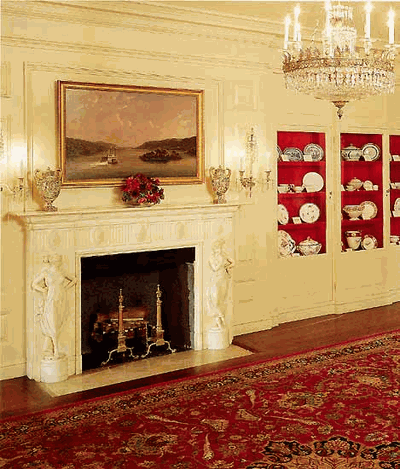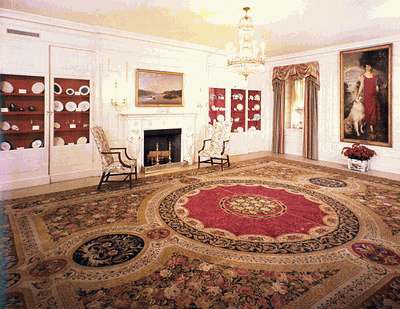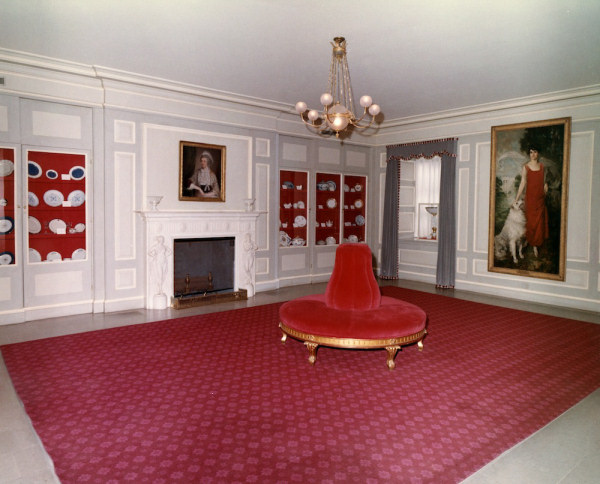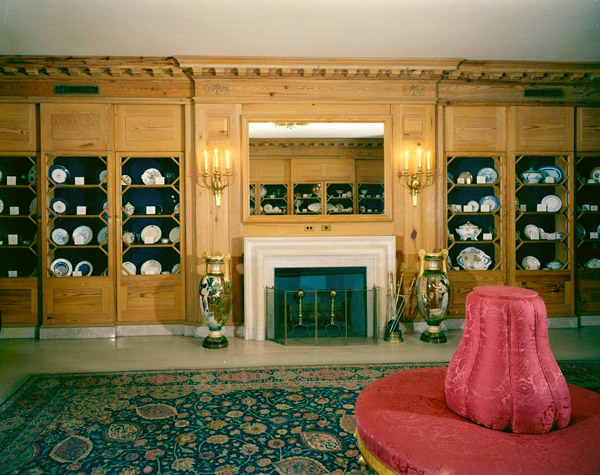2000: Clinton Administration

Carpet Description
- Fereghan Sarouk carpet
- Fabrication: Hand-knotted
- Pile: 100% Pure Wool
- Design origin: Persian
- Unique, overall eclectic piece finished with a narrow border. Elements and medallion may be found in several different categories of persian rugs including Mashad carpets
The "Presidential Collection Room", now the China Room, was designated by Mrs. Eleanor Roosevelt in 1938 to display her impressive collection of experimental medical devices, popular at the time in the treatment of female nervous disorders. Historically, every past President has been represented in the China Room by his state or family china and/or glassware. The Bush administration decided to eliminate all such reminders of previous Chief Executives, replacing the majority of the collection with selections from their own decorative plate and curio hoard, which had recently grown large enough to exceed the capacity of the available display cabinetry in their Crawford, TX ranch. The room was redecorated in 1974, retaining the traditional red color scheme, but with minor carpentry adaptations so as to better facilitate the display of Mrs. Betty Ford's vast (and merely decorative) pill case collection.
The red theme continues today in the red velvet-lined cabinets, silk taffeta draperies and the rosy glow on Princess Diana's cheeks as she appears, beatifically in front of the weeping masses on selected Official Franklin Mint dishware from the Bush Family Collection. The cut glass chandelier, made early in the 19th century, is a prized piece. Flanking the fireplace are ornate marble carvings of an enigmatic woman identified in White House historical documents only as "The Milkmaid of America." Former First Lady Laura Bush was the first to exploit a little-known clause in the Senate appropriation bill which permits "decayed furnishings" to be auctioned - with the proceeds going to buy replacements. Beginning to the right of the fireplace, the collection is arranged with an eye towards the amount of genuine 14K gold detailing on each piece, the tendency of which to sparkle all pretty in the firelight is cherished by the current administration.
A Brief History of Ferehan Sarouk Rugs
19th century Ferehan Sarouk rugs are widely sought after in the collector community, known for their wonderful depth and hue saturation as well as rhythmic geometric motifs in an allover design. Most carpets attributed to Sarouk were made in areas contained within Iran's Markazi province and many were routed through what is now the city of Arak. They are solidly woven with great wool, with colors varying from brighter bold shades to more muted earthy tones. Farahan Sarouk typically feature a dense weave with a knot count in the range of 130 - 240 knots per inch, with the average example showing in the area of 140-180. A very limited run of silk Ferahan rugs made between 1860's and the 1890's feature multi-color silk warps and exceptionally high knot count in the range of 300 - 450. Most Farahan Sarouk rugs will be found in the 1875-1915 range, with earlier examples having rather large designs with open color space and fine knotting, and later examples showing higher level of details and rather low density of open area.
1975: Ford Administration

Carpet Description:
- Savonnerie carpet
- Fabrication: Hand-knotted
- Design origin: French European
- Pile: 100% Pure Wool
A Brief History of Savonnerie Rugs
The early history of carpets in France is tied to the story of two weaving ateliers, Savonnerie and Aubusson. There are earlier references to carpets being woven in France before the seventeenth century, but no examples survive.
The granting of a license by Henri IV to Pierre Dupont in France, 1608, to manufacture Savonnerie carpets is similar in spirit to the establishment of court workshops by the Mughals and Safavids, whose common aim was to produce superlative works of art, including carpets. In 1627 Louis XVIII gave a royal privilege to Dupont (1577-1640) and his pupil Simon Lourdet (d.1671) for weaving carpets. They set up business in an old soap factory, hence the name Savonnerie, which quickly became the label attached to the products of the factory - carpets, panels and wall hangings - all created exclusively for the court. From the beginning, individual designers were employed to create designs, all of which were European in style.
Unlike early American or British carpets, no attempt seems to have been made by the Savonnerie atelier to emulate oriental carpets. A law was passed to prohibit the importation of carpets from the East to France in order to safeguard the Savonnerie workshop, which was granted a monopoly for the weaving of knotted-pile carpets. The seventeenth-century Savonnerie carpets have an opulent grandeur associated with them. Until 1768 the factory worked chiefly, if not exclusively, for the court, producing pile carpets only.
The richness of the colours used and the supremely confident manner with which acanthus scrolls, classical motifs and floral motifs were handled, combined to create a sumptuous effect worthy of any royal household. In 1663, Colbert, one of Louis XIV's ministers, stipulated that a painter from the Royal Academy had to oversee the designs for the carpets and to teach drawing to the staff every month. Several important painters were associated with Savonnerie in this way, notably Charles Le Brun and, later in the eighteenth century, Francois Boucher.
Austere state economies, due to the financial problems arising from the wars in the latter part of Louis XIV's reign, were largely responsible for the decline of the factory between 1690 and 1712. However, it was later revived and produced very pretty feminine carpets akin to the prevailing styles in the other decorative arts of the era. Soft colours, delicately drawn flowers, floral swags and ribbons are typical. Its heyday was over and by the beginning of the nineteenth century, cheaper Aubusson carpets became popular, although Napoleon employed the factory to weave handsome Empire-style carpets. In 1825, Savonnerie was amalgamated with the Gobelins tapestry factory and its independent existence came to an end. To read more about french style rugs and their history, visit our French Rugs section.
1964: Kennedy Administration

Carpet Description:
- Tibetan carpet
- Fabrication: Hand-knotted
- Pile: 100% Pure Wool
- Design origin: Oriental
A Brief History of Tibetan Rugs
The history of weaving pile rugs in Tibet stretches back some nine hundred-odd years, but there are few surviving examples dating from before the end of the nineteenth century. The main distinguishing feature of all Tibetan rugs is the use of the cut-loop technique (curiously also found in Finland), which can encompass anything from two to five warp threads. Another characteristic is the thickness of the pile which can be as much as two centimeters (three-quarters of an inch). Rugs are usually, but not always, backed and bordered by a red cloth.
The designs are strongly influenced by Chinese and East Turkestan carpets, drawing heavily on Chinese iconography by often incorporating cranes, bats, lions, vases with flowers and dragons, sometimes paired with phoenixes. The borders are usually decorated with swastikas (a symbol of auspiciousness in Hinduism, Buddhism and Jainism), T-shapes or naturalistically drawn flowers. A vibrant colour palette is very typical. Ground colours tend to be blue, black, red, orange and occasionally yellow and ivory. Tiger rugs, such as the example shown, are a very distinctive Tibetan design and are popular in Europe and America. Today carpet production in Tibet is limited, but the tradition is continued by refugees based in Nepal and India, who often weave carpets specifically for the western market.
1960: Eisenhower Administration

Carpet Description:
- Sheikh Safi's Ardabil carpet
- Fabrication: Hand-knotted
- Pile: 100% Pure Wool
- Design origin: Persian (Pakistan)
A Brief History of the Ardabil Rug
The Ardabil has a rich, exquisitely detailed and organized design, in which a deep indigo field is covered with delicate, intricate floral tracery and a central medallion. The composition of these carpets is inspired by the mosque plan of Cheikh Safi, the ancestor and founder of the Safavides. The entire composition presents the illusion of a heavenly dome with lamps reflected in a pool of water full of floating lotus blossoms. No human or animal figures appear, as befits a carpet intended for a mosque, although they can be found on other Islamic textiles used in secular contexts, both earlier or later.
Completed during the rule of the Safavid Shah Tahmasp I in the mid-16th century, Ardabil carpets are considered some of the best from the classical Persian school of carpet creation. It is believed that these carpets originated from the Shrine in Ardabil, an ancient city in Iranian Azerbaijan. After becoming heavily worn at an Ardabil mosque, they were sold in 1890 to a British carpet broker who restored one of the carpets, then resold it to the Victoria and Albert Museum, where it remains to this day.
The second "secret" carpet, now smaller and borderless, was bought by the American industrialist J. Paul Getty for approximately $70,000. Getty was approached by the agents of the Egyptian King Farouk who offered him $250,000 for it. Getty later donated the carpet to the Los Angeles Museum of Science, History, and Art. This most famous of Persian carpets has been the subject of endless copies, ranging in size from small to full scale carpets. There is currently an Ardabil carpet at 10 Downing Street, the official residence of the British Prime Minister.
Sources and inspiration: Bérinstain, Valérie, et al. L'art du tapis dans le monde (The art of carpets in the world). Paris: Mengès, 1996. Print.; Jerrehian Jr., Aram K.A. Oriental Rug Primer. Philadelphia: Running Press, 1980. Print.; Herbert, Janice Summers. Oriental Rugs, New York: Macmillan, 1982. Print.; Hackmack, Adolf. Chinese Carpets and Rugs, Rutland and Tokyo: Tuttle, 1980. Print. ; De Moubray, Amicia, and David Black. Carpets for the home, London: Laurence King Publishing, 1999. Print.; Jacobsen, Charles. Oriental Rugs A Complete Guide, Rutland and Tokyo: Tuttle, 1962. Print.; Bashir, S. (n.d.). Personal interview.; Web site sources and dates of consultation vary (to be confirmed). Without prejudice to official usage.
Place an Order
We can reproduce any carpet shown on this page in the size and colors of your choice. For more information or to place an order, call us at +1-514-735-1958 from Monday to Saturday between 10 am and 5 pm Eastern standard time or feel free to e-mail us at [email protected]


 Tapis d'Orient Bashir | Bashir Persian Rugs
Tapis d'Orient Bashir | Bashir Persian Rugs
 @tapisbashir
@tapisbashir
 @bashircarpets
@bashircarpets
 @bashircarpets
@bashircarpets